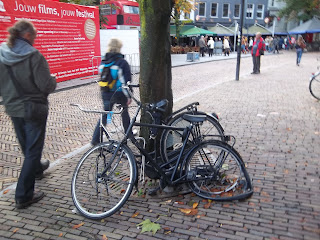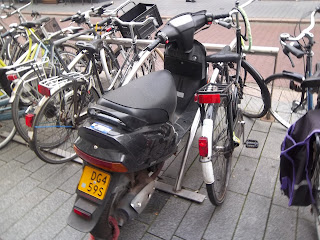We are always on the look out for new places to visit in the Netherlands. And 's-Hertogenbosch, or Den Bosch for short, came highly recommended, as a city with plenty of character and atmosphere.
's-Hertogenbosch (Duke's wood) is the capital of Brabant, which is a south eastern province of the Netherlands. It was settled in 1150, in an area with high sand bars in a swampy and wooded delta between the rivers Dommel and Aa. Part of the city wall is still visible, although the city has grown somewhat.
One of the significant features of 's-Hertogenbosh are the waterways, which form part of the river, Binnendieze. These waterways (canals) flow in, around and under the houses. In past times the waterways were used to transfer goods from the harbour in Vughterstroom. But the water was also used in the leather, metal and brewing industries, as well as for drinking water, cooking water and sewage. The mind boggles!
After 1874, when the water was not needed for other purposes, the waterways were still used as an open sewer. In fact it was not until 1964 that an enclosed sewerage system was installed, so up up until then, it must have been a very smelly city! Since the 1970's there has been an extensive restoration programme of a small proportion of the waterways (3.5 kms). Originally there were 12 kms of waterways with 20 crossings and more than 100 bridges. I presume these waterways are still there, somewhere, under the streets and buildings. Residents must need to be careful, when digging holes in their gardens.
We set off, reasonably early in the morning, in order to catch the train, which took a very pleasant half an hour to reach 's-Hertogenbosch. The railway station is very ornate.
We walked through many narrow streets, with beautiful buildings and small gardens. 's-Hertogenbosch appears to be a very affluent city, from the appearance of the houses and well dressed people.
The very well maintained paved streets.
Mia and Abi peering through the windows of an outdoor cafe. The greenery covering the wall is artificial! But very effective.
All ready for a trip on the Binnendieze, that is, a trip through the old sewers! A very narrow boat, for extremely narrow waterways. No hands outside the boat, and we had to duck on many occasions due to the low 'ceilings' of the canals..
The cruise was described as experiencing the Binnendieze as an oasis of stillness in the middle of a bustling city. And this was so true, due to the thickness of the walls, and arches, and the buildings above. It was silent, except for Raphy telling us in a very loud voice, that it was scary. And I agree with him. The waterways were full of cobwebs, bat houses, old sewage outlets and long stretches of complete darkness.
We sailed under an original Gothic Convent Church built in 1533, and under the Town Hall where there are steps, which wedding parties use when they arrive for a wedding ceremony in the Town Hall. An interesting way to arrive at the Registry Office, in all your wedding finery. Not in a limousine, or by horse and carriage, but in a canal boat through the old sewers. There is also an enormous glass tile, which you can look up into, and see the inside of the Town Hall.
Altogether a fascinating canal trip.
The main Cathedral, Sint-Janskathdral (a Basilica really), is very impressive with its high dome and stained glass windows. It is still a Catholic Church, which is not unusual in Brabant, being a very Catholic area of the Netherlands. I think it started as a Gothic church, as it is very ornate on the outside, but the inside is definitely Norman, with all its huge windows. It was too difficult to get a decent photograph of the church, as it was too large.
But I did photograph the church below. And when I went to have a look inside, I found it was, in fact, an art gallery! Too pricey to visit, sadly. Lovely art deco building.
Mia posing in front of the water fountain, very arty. The fountain that is, but then Mia, fits in very well with her blond hair, and red and pink clothes.
Talking about art. This spectacle shop certainly wins tops marks for its sculptures.
A very narrow house!
There many, many restaurants and cafes in 's-Hertogenbosch, with the heaters already on outside, all for the customers comfort. We called into a cafe, for some coffee and cake. Not very gezillig (cosy, pleasant, sociable) when you have three children and a buggy. But we managed, as we were all very tired.
Now what is this? An ornate walkway over the canal? A narrow market? None of these. It was once the public toilets, the contents of which, dropped straight into the waterway below. A loo with a view! No longer toilets, of course, and much restored. A very interesting piece of information gained from the canal ride.
A return visit to this very charming city is a must. And on the last note, if you are a female living in this city, than the required piece of clothing is a very tight, and expensive, jacket. A generalisation, of course, but I saw more tight fitting jackets, seemingly about one size too small for the wearer, than I have seen anywhere else in the Netherlands.


























































